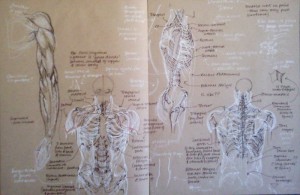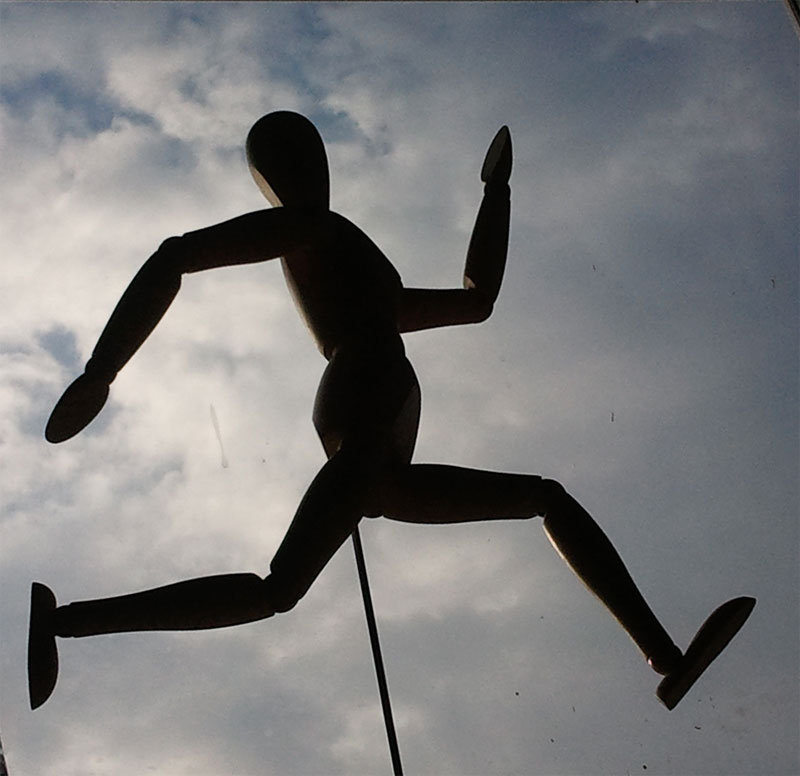When I first started trying to learn anatomy I found it really difficult. I knew it would really improve my drawing but I wasn’t sure exactly how. I was (and still am) finding it so hard; I decided to analyse why I am trying to learn and what it will do for my drawing. My aim is to create a strategy that will help me learn what I need as quickly and easily as possible.

A basic knowledge of anatomy will help me to avoid some common drawing mistakes, drawing torsos too short is one I make often. A more in depth knowledge will provide me with the tools to tackle more exciting ideas and projects and allow me to get the most out of my drawing opportunities.
What you think you see, OR What you think, you see…
It is hard to avoid drawing what you think and rather than what is really there. It is often said that we ‘see with our brains and not our eyes’. So as we draw we are using constructs in our minds, as well as a drawing on paper. We can use this to our advantage, since changing what we think will change what we see. We are effectively upgrading a simplistic mental image/construct with a more structured one, for example thinking of the eye as a covered ball, instead of an almond shape. I think that upgrading this mental library is one of the most important goals of learning anatomy.
What you want to see
More extensive anatomical knowledge allows you to to draw without always needing a model in front of you. I would really like to be able to:
- Complete drawings when the model has stopped posing. I often run out of time in a pose, so this would be helpful.
- Draw the figure from very different angles and perspectives, especially where the poses I would like would be too difficult, or cannot be sustained for long periods of time.
- Create compositional arrangements without needing a model. I want to test out some ideas and arrangements before hiring a model.
I know that with sufficient anatomical knowledge I could draw the figure without the model but I think that there is far more to drawing from a model than anatomy. You are drawing a feeling, thinking presence; a living soul.
Seeing, thinking, feeling?
Anatomy gives the structure of the figure and governs the basic mechanics of the body, beyond this it is a guide to body type, habitual patterns of use, muscle development etc. These ideas allow us to better understand the postures and motions, tensions and gestures of a model. In terms of drawing this understanding can to help communicate movement, direction, intention and emotion.
On a fundamental level anatomy is vital to creating a plausible figure drawing but my experience has been that the more I learn the more useful it becomes. Greater knowledge gives more creative opportunities, allowing you to create what you want to see. Beyond that the realm of possibilities expands further into gesture, movement and the expression of emotion.
A Learning Strategy
So how does this help? You may be wondering. Well, since what we see relies on what we know, we can change what we ‘know’. That is, we can construct for ourselves a new mental library of the shapes (and volumes) of the body and how they fit together. When that is well established I would focus on the effects of changes in the relationships between the parts to try and understand tension, movement and so on.
I do think that constructing a mental library of the body will be difficult, and perhaps the trickiest part will be creating sufficiently simple concepts for myself. I want to make things as simple as I possibly can because that makes it easier to learn initially and will allow me to selectively add more complex information as (and only as) required.
If you’d like to know more look out for my posts about learning anatomy.


Pingback: Learning Anatomy | Metadrawer
Very nicely explained Helen.
Thanks Ewan